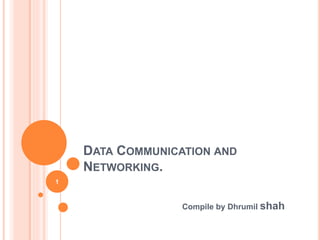
Lec1 :- Data communication and network
- 1. DATA COMMUNICATION AND NETWORKING. Compile by Dhrumil shah 1
- 2. 1.2 Chapter 1 Introduction 1. Introduction 2. Fundamental characteristics 3. Components of data communication 4. Data representation 5. Data Flow
- 3. 1.3
- 4. SIMPLE DATA COMMUNICATION MODEL Simplified block diagram of data communication network
- 5. SIMPLE DATA COMMUNICATION MODEL Source :Where the data is originated. Transmitter : Convert data into suitable form for transmission through the medium Communication System: Medium through which signal is sent. Receiver : Which receives the signal and convert it into data or message. Destination : where the data is sent. 1.5
- 6. FUNDAMENTAL CHARACTERISTICS OF DATA COMMUNICATION Delivery : The system must deliver data to the correct destination Accuracy : The system must deliver data accurately Timeliness : The system should transfer data within time . Jitter : It refers to the variation in the packets arrival tome . 1.6
- 8. 1.8 Figure 1.1 Components of a data communication system
- 10. 1.10 1-1 DATA COMMUNICATIONS The term telecommunication means communication at a distance. The word data refers to information presented in whatever form is agreed upon by the parties creating and using the data. Data communications are the exchange of data between two devices via some form of transmission medium such as a wire cable.
- 11. 1.11 Figure 1.2 Data flow (simplex, half-duplex, and full-duplex)
- 12. TRANSMISSION MODES Simplex signals transmitted in one direction eg. Television Half duplex both stations transmit, but only one at a time eg. police radio Full duplex simultaneous transmissions eg. telephone
- 13. 1.13
- 14. 1.14 NETWORKS A network is a set of devices (often referred to as nodes) connected by communication links. A node can be a computer, printer, or any other device capable of sending and/or receiving data generated by other nodes on the network. A link can be a cable, air, optical fiber, or any medium which can transport a signal carrying information. Topics discussed in this section: Network Criteria Physical Structures Categories of Networks
- 15. Performance Depends on Network Elements Measured in terms of Delay and Throughput Reliability Failure rate of network components Measured in terms of availability/robustness Security Data protection against corruption/loss of data due to: Errors Malicious users 1.15 Network Criteria
- 16. Type of Connection Point to Point - single transmitter and receiver Multipoint - multiple recipients of single transmission Physical Topology Connection of devices Type of transmission - unicast, mulitcast, broadcast 1.16 Physical Structures
- 17. 1.17 Figure 1.3 Types of connections: point-to-point and multipoint
- 18. 1.18 Figure 1.4 Categories of topology
- 19. 1.19 Figure 1.5 A fully connected mesh topology (five devices)
- 20. 1.20 Figure 1.6 A star topology connecting four stations
- 21. 1.21 Figure 1.7 A bus topology connecting three stations
- 22. 1.22 Figure 1.8 A ring topology connecting six stations
- 23. 1.23 Figure 1.9 A hybrid topology: a star backbone with three bus networks
- 24. Local Area Networks (LANs) Short distances Designed to provide local interconnectivity Wide Area Networks (WANs) Long distances Provide connectivity over large areas Metropolitan Area Networks (MANs) Provide connectivity over areas such as a city, a campus 1.24 Categories of Networks
- 25. Figure 1.10 An isolated LAN connecting 12 computers to a hub in a closet 1.25
- 26. 1.26 Figure 1.11 WANs: a switched WAN and a point-to-point WAN
- 27. Figure 1.12 A heterogeneous network made of four WANs and two LANs 1.27
- 28. 1.28 1-3 THE INTERNET The Internet has revolutionized many aspects of our daily lives. It has affected the way we do business as well as the way we spend our leisure time. The Internet is a communication system that has brought a wealth of information to our fingertips and organized it for our use. Topics discussed in this section: Organization of the Internet Internet Service Providers (ISPs)
- 29. 1.29 Figure 1.13 Hierarchical organization of the Internet
- 30. 1.30 1-4 PROTOCOLS A protocol is synonymous with rule. It consists of a set of rules that govern data communications. It determines what is communicated, how it is communicated and when it is communicated. The key elements of a protocol are syntax, semantics and timing Topics discussed in this section: Syntax Semantics Timing
- 31. Syntax Structure or format of the data Indicates how to read the bits - field delineation Semantics Interprets the meaning of the bits Knows which fields define what action Timing When data should be sent and what Speed at which data should be sent or speed at which it is being received. 1.31 Elements of a Protocol
